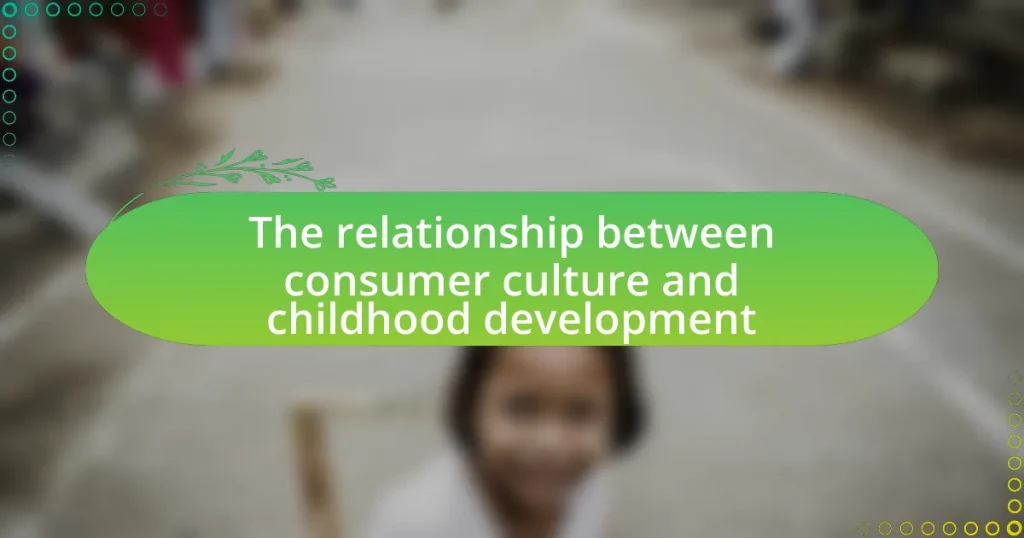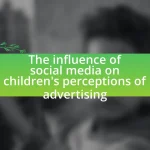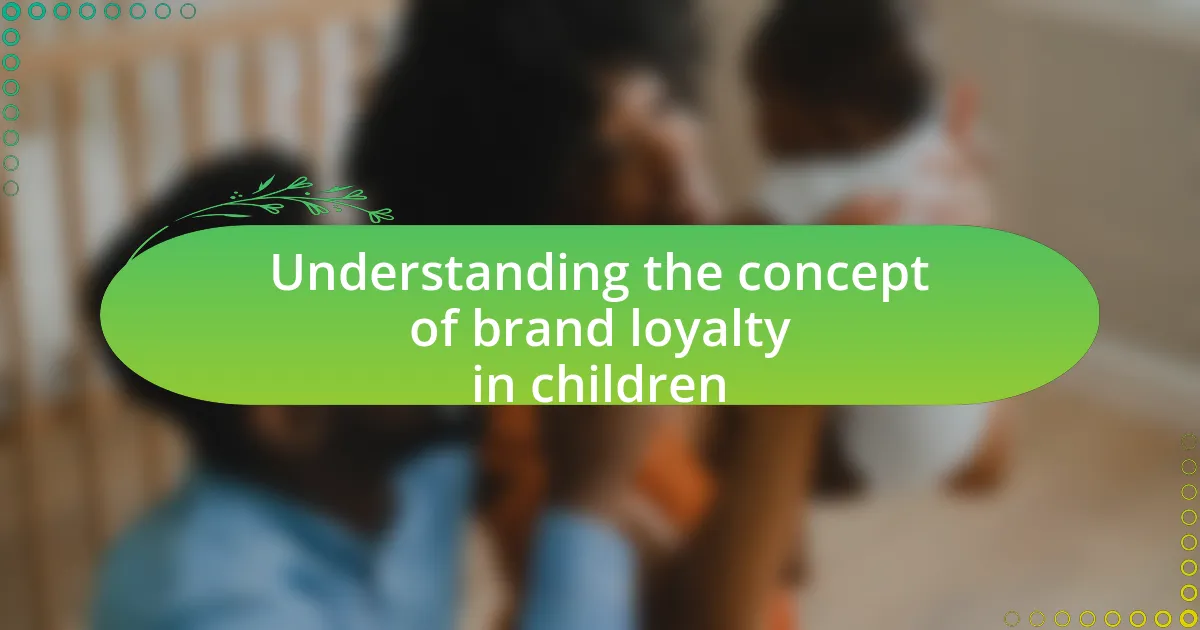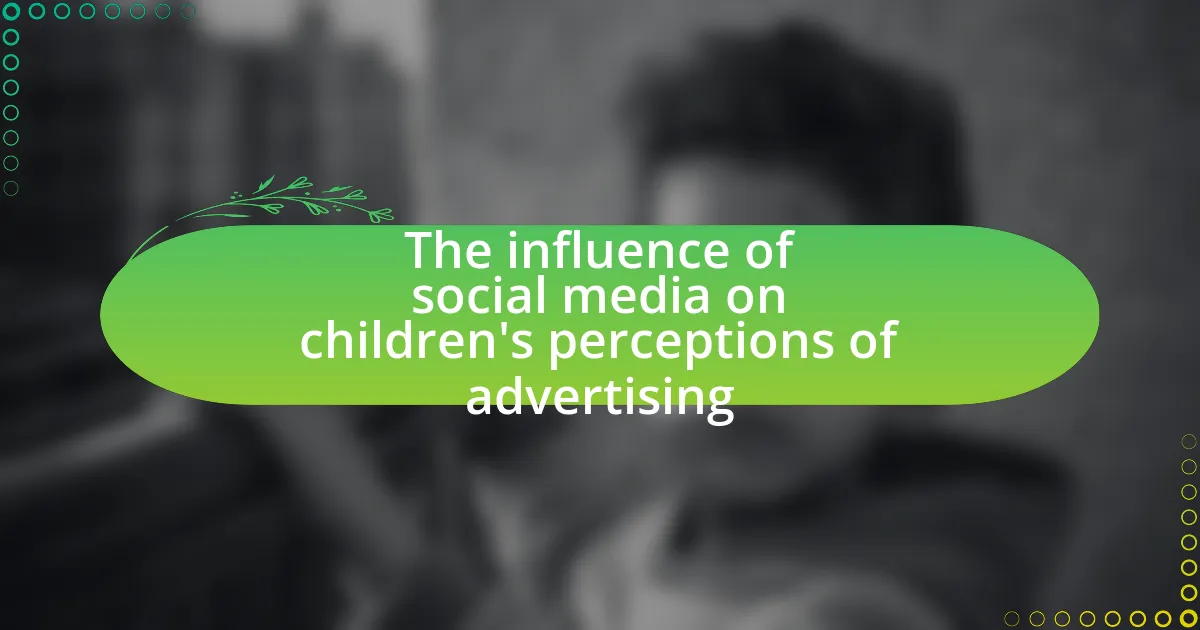The article examines the relationship between consumer culture and childhood development, highlighting how exposure to advertising, materialism, and social norms influences children’s identities, values, and behaviors. It discusses the detrimental effects of consumer culture on children’s self-esteem, emotional well-being, and social interactions, emphasizing the role of peer influence and digital consumption. Key aspects such as advertising exposure, materialistic values, and brand loyalty are analyzed, along with strategies for parents and educators to mitigate negative impacts and promote healthier developmental outcomes. The article underscores the importance of fostering critical thinking and media literacy to help children navigate the complexities of consumer culture effectively.
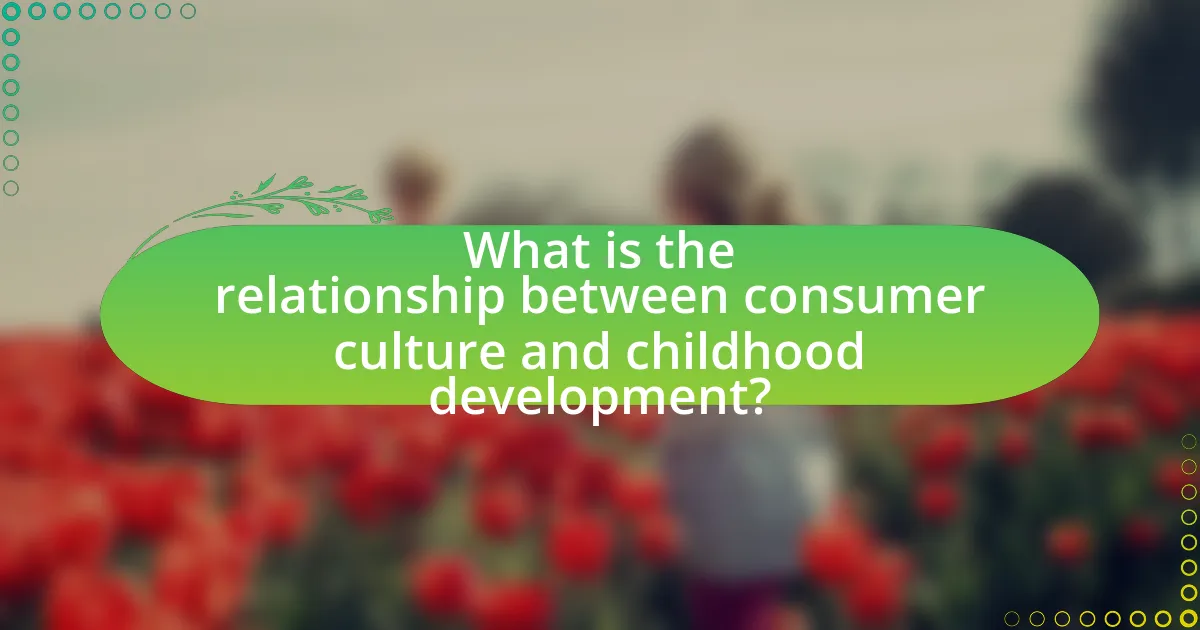
What is the relationship between consumer culture and childhood development?
Consumer culture significantly influences childhood development by shaping children’s identities, values, and behaviors. This influence manifests through exposure to advertising, materialism, and social norms that prioritize consumption. Research indicates that children who are immersed in consumer culture often develop a sense of self-worth tied to material possessions, which can lead to increased consumerism and diminished intrinsic motivation. For instance, a study published in the Journal of Consumer Research by authors such as John A. Deighton and others highlights how marketing strategies target children, impacting their preferences and social interactions. This relationship underscores the importance of understanding consumer culture’s role in shaping developmental outcomes in childhood.
How does consumer culture influence childhood development?
Consumer culture significantly influences childhood development by shaping children’s values, behaviors, and social interactions. This influence manifests through exposure to advertising, which often promotes materialism and consumerism as pathways to happiness and social acceptance. Research indicates that children who are heavily exposed to consumer culture tend to prioritize possessions over relationships, leading to a decrease in social skills and emotional well-being. For instance, a study published in the Journal of Consumer Research found that children who engage with commercial media are more likely to exhibit materialistic values, which can hinder their ability to form meaningful connections with peers.
What are the key aspects of consumer culture that affect children?
Key aspects of consumer culture that affect children include advertising exposure, materialism, peer influence, and digital consumption. Advertising exposure significantly shapes children’s preferences and behaviors, with studies indicating that children aged 2 to 11 see an average of 25,600 advertisements annually, which can lead to increased materialistic values. Materialism, fostered by consumer culture, correlates with lower self-esteem and higher levels of anxiety among children, as evidenced by research published in the Journal of Consumer Research. Peer influence also plays a crucial role, as children often feel pressure to conform to their peers’ consumption patterns, impacting their choices and self-identity. Lastly, digital consumption, particularly through social media and online platforms, exposes children to targeted marketing and influencer culture, further shaping their desires and expectations.
How do children perceive and interact with consumer culture?
Children perceive and interact with consumer culture primarily through exposure to advertising, peer influence, and parental guidance. Research indicates that children as young as two years old can recognize brand logos and associate them with specific products, demonstrating an early understanding of consumer identity. For instance, a study published in the journal “Pediatrics” found that children who are frequently exposed to advertisements are more likely to request advertised products, indicating a direct interaction with consumer culture. Additionally, children often mimic the consumption behaviors of adults and peers, which shapes their preferences and purchasing decisions. This interaction is further influenced by the emotional connections they develop with brands, as evidenced by findings from the “Journal of Consumer Research,” which highlight that children form attachments to brands that resonate with their self-image and social aspirations.
Why is understanding this relationship important?
Understanding the relationship between consumer culture and childhood development is important because it influences children’s values, behaviors, and identity formation. Research indicates that exposure to consumer culture can shape children’s perceptions of self-worth and social status, often linking them to material possessions. For instance, a study by the American Psychological Association found that children who are heavily exposed to advertising are more likely to develop materialistic values, which can impact their emotional well-being and social relationships. This understanding is crucial for parents, educators, and policymakers to foster healthier developmental environments that prioritize intrinsic values over materialism.
What implications does consumer culture have on children’s values and behaviors?
Consumer culture significantly influences children’s values and behaviors by promoting materialism and shaping their social interactions. Children exposed to consumer culture often prioritize possessions and status over intrinsic values such as kindness and empathy. Research indicates that children who engage with advertising and consumerism are more likely to develop a desire for material goods, which can lead to a diminished sense of self-worth and increased peer pressure to conform to consumerist ideals. A study by the American Psychological Association found that children as young as 8 years old can recognize and internalize marketing messages, which affects their preferences and behaviors, reinforcing the cycle of consumerism.
How can awareness of this relationship impact parenting and education?
Awareness of the relationship between consumer culture and childhood development can significantly enhance parenting and education strategies. By understanding how consumer culture influences children’s values, behaviors, and self-esteem, parents can make more informed decisions about media exposure and material possessions. Research indicates that children exposed to high levels of consumer advertising are more likely to develop materialistic attitudes, which can negatively affect their emotional well-being and social relationships. For instance, a study published in the Journal of Consumer Research found that children who frequently engage with advertisements are more likely to prioritize possessions over experiences, leading to lower life satisfaction. Consequently, parents and educators can foster resilience and critical thinking by promoting values such as gratitude and mindfulness, counteracting the negative effects of consumerism. This awareness allows for the development of curricula that emphasize social-emotional learning, helping children navigate the complexities of consumer culture while supporting their overall development.
What are the effects of consumer culture on children’s psychological development?
Consumer culture significantly impacts children’s psychological development by shaping their self-esteem, identity formation, and social behaviors. Exposure to consumerism often leads children to equate self-worth with material possessions, fostering a sense of inadequacy when they cannot access desired products. Research indicates that children raised in consumer-oriented environments may develop higher levels of anxiety and lower self-esteem due to constant comparisons with peers and media portrayals of success linked to consumption. A study published in the Journal of Consumer Research by authors such as Melnyk and Van Herpen highlights that children who are heavily influenced by advertising are more likely to exhibit materialistic values, which can hinder their emotional well-being and interpersonal relationships.
How does exposure to advertising shape children’s self-esteem?
Exposure to advertising significantly shapes children’s self-esteem by influencing their perceptions of self-worth and body image. Research indicates that children exposed to idealized images and messages in advertisements often develop unrealistic standards for themselves, leading to feelings of inadequacy and lower self-esteem. A study published in the Journal of Advertising Research found that children who frequently view advertisements are more likely to compare themselves to the portrayed ideals, which can result in negative self-evaluations. Furthermore, the American Psychological Association has noted that such exposure can contribute to body dissatisfaction and a desire for products that promise to enhance attractiveness, further impacting self-esteem negatively.
What role does media play in shaping children’s body image?
Media significantly influences children’s body image by promoting idealized and often unrealistic standards of beauty. Research indicates that exposure to media representations, such as advertisements and television shows, correlates with body dissatisfaction among children. For instance, a study published in the journal “Pediatrics” by Tiggemann and Slater (2014) found that girls who frequently viewed thin-ideal media were more likely to express dissatisfaction with their own bodies. This effect is compounded by social media, where curated images can lead to negative self-perception and increased pressure to conform to these ideals. Thus, media serves as a powerful tool in shaping children’s perceptions of their bodies, often leading to harmful outcomes.
How do materialistic values affect children’s emotional well-being?
Materialistic values negatively affect children’s emotional well-being by fostering feelings of inadequacy and low self-esteem. Research indicates that children who prioritize material possessions often experience higher levels of anxiety and depression, as they equate self-worth with material success. A study published in the Journal of Consumer Research found that children exposed to materialistic messages are more likely to report dissatisfaction with their lives and relationships, leading to emotional distress. This correlation suggests that an emphasis on materialism can undermine children’s ability to form healthy emotional connections and develop a positive self-image.
In what ways does consumer culture affect children’s social development?
Consumer culture significantly affects children’s social development by shaping their values, behaviors, and interactions with peers. Exposure to consumerism often leads children to prioritize material possessions over relationships, fostering a sense of competition and comparison among peers. Research indicates that children who are heavily influenced by consumer culture may develop lower self-esteem and increased anxiety due to the pressure to conform to societal standards of success, which are often defined by material wealth. For instance, a study published in the Journal of Consumer Research found that children exposed to advertisements emphasizing luxury items were more likely to exhibit materialistic values and less likely to engage in prosocial behaviors, such as sharing and cooperation. This shift in focus can hinder the development of essential social skills, such as empathy and collaboration, which are crucial for healthy interpersonal relationships.
How do peer influences related to consumerism impact social interactions?
Peer influences related to consumerism significantly impact social interactions by shaping individuals’ behaviors, preferences, and social dynamics. When children and adolescents observe their peers engaging in consumerist behaviors, such as valuing material possessions or brand loyalty, they are likely to adopt similar attitudes to fit in or gain social acceptance. Research indicates that peer pressure can lead to increased spending on trendy items, which in turn affects group cohesion and social status among peers. For instance, a study published in the Journal of Consumer Research found that adolescents are more likely to purchase luxury brands when they perceive their friends valuing those brands, highlighting the direct correlation between peer influence and consumer behavior. This dynamic can create a cycle where social interactions are heavily influenced by materialism, potentially leading to superficial relationships based on shared consumer interests rather than deeper connections.
What are the effects of brand loyalty on children’s friendships?
Brand loyalty can significantly influence children’s friendships by shaping their social interactions and peer relationships. Children who exhibit strong brand loyalty often seek out peers who share similar preferences, which can lead to the formation of exclusive social groups centered around specific brands. This exclusivity can create social pressure to conform to brand preferences, potentially leading to conflicts with peers who prefer different brands. Research indicates that children as young as 6 years old can develop brand loyalty, which can affect their social dynamics, as they may prioritize brand-related discussions and activities over other interests. Consequently, brand loyalty can both strengthen bonds among like-minded peers and create divisions among those with differing brand affiliations.
How can parents and educators navigate consumer culture’s impact on children?
Parents and educators can navigate consumer culture’s impact on children by fostering critical thinking and media literacy skills. By encouraging children to analyze advertisements and understand the motives behind marketing, adults can help them become more discerning consumers. Research indicates that children exposed to media literacy programs show improved critical thinking skills and are less susceptible to advertising pressures (Levine, 2016, “Media Literacy: A Key to Critical Thinking,” Journal of Media Literacy Education). Additionally, promoting discussions about values and needs versus wants can empower children to make informed choices, reducing the influence of consumer culture on their self-esteem and identity.
What strategies can be employed to mitigate negative effects?
To mitigate negative effects of consumer culture on childhood development, strategies such as promoting media literacy, encouraging critical thinking, and fostering emotional intelligence can be employed. Media literacy education equips children with the skills to analyze and critically evaluate advertisements and media messages, reducing susceptibility to manipulative marketing tactics. Research indicates that children who receive media literacy training demonstrate improved critical thinking skills and are less influenced by consumer pressures. Additionally, encouraging critical thinking through discussions about consumerism helps children understand the implications of their choices, fostering a more conscious approach to consumption. Lastly, fostering emotional intelligence enables children to recognize and manage their emotions, which can reduce the impact of peer pressure related to consumer culture. Studies show that children with higher emotional intelligence are better equipped to resist negative influences and make healthier choices.
How can parents foster critical thinking about consumer messages?
Parents can foster critical thinking about consumer messages by engaging children in discussions about advertisements and marketing strategies. By analyzing specific ads together, parents can encourage children to question the intent behind the messages, such as identifying persuasive techniques like emotional appeals or celebrity endorsements. Research indicates that children who participate in such discussions develop a better understanding of consumer motives and are more likely to make informed choices (Lindstrom & Seybold, 2003). This active engagement not only enhances critical thinking skills but also empowers children to navigate consumer culture effectively.
What role can schools play in educating children about consumer culture?
Schools play a crucial role in educating children about consumer culture by integrating lessons on financial literacy, critical thinking, and media literacy into their curricula. By teaching students how to analyze advertisements, understand the implications of consumer choices, and manage personal finances, schools equip children with the skills necessary to navigate a consumer-driven society. Research indicates that early exposure to financial education can lead to better decision-making regarding spending and saving, as highlighted in a study by the National Endowment for Financial Education, which found that students who receive financial education are more likely to demonstrate responsible financial behaviors. Thus, schools serve as foundational institutions in shaping informed consumers who can critically engage with the complexities of consumer culture.
What best practices can help promote healthy development in a consumer-driven society?
Promoting healthy development in a consumer-driven society can be achieved through fostering critical thinking skills in children. Encouraging children to question advertising messages and understand the difference between needs and wants helps them develop a more discerning approach to consumption. Research indicates that children who engage in media literacy programs show improved critical thinking and decision-making skills, which are essential in navigating consumer culture. Additionally, promoting experiences over material goods, such as family outings or educational activities, can enhance emotional well-being and social skills, as studies have shown that experiences contribute more significantly to long-term happiness than material possessions.
How can families create a balanced approach to consumption?
Families can create a balanced approach to consumption by establishing clear guidelines that prioritize needs over wants, fostering critical thinking about purchases, and encouraging sustainable practices. This approach involves setting budgets, discussing the implications of consumer choices, and promoting experiences over material goods. Research indicates that children who engage in discussions about consumption with their families develop better decision-making skills and a greater understanding of financial literacy, which positively impacts their overall development.
What resources are available for parents to support children’s development in this context?
Parents can access various resources to support children’s development in the context of consumer culture. These resources include educational programs that focus on media literacy, which help children critically analyze advertisements and consumer messages. For instance, organizations like Common Sense Media provide guidelines and tools for parents to navigate media consumption effectively. Additionally, workshops and seminars offered by local community centers often address the impact of consumer culture on child development, equipping parents with strategies to foster healthy consumption habits. Research indicates that children exposed to media literacy education demonstrate improved critical thinking skills regarding advertising (Levine, 2018, Journal of Consumer Research).
